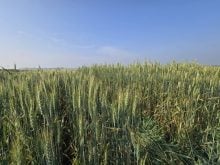RESEARCH Ninety-year-old rotations show compounding nature of systemic production changes
When one part of an agricultural system is changed, the effects are frequently found in unexpected places.
For example, the earliest no-till farmers were hoping for soil conservation benefits. Research now shows fields in long-term no-till require less fertilizer.
Miles Dyck, a University of Alberta soil scientist, provided that information at the Manitoba Agronomists’ Conference this past winter, noting the result from North Dakota State University research.
“They had to change the fertilizer recommendations for the fields that had been under no-till for a while compared to conventional management,” he said. “So this is an example of how a change in management can affect soil properties and processes.”
Read Also

Manitoba Ag Days 2026 coming up fast
Canada’s largest indoor farm show, Manitoba Ag Days, returns to Brandon’s Keystone Centre Jan. 20-22, 2026. Here’s what to expect this year.
There have been many changes in the North American Great Plains over the last 20 to 30 years. There’s greater diversity in crops and rotations and higher-yielding cultivars.
“So this is bound to affect our nutrient cycling and, oddly enough, we can show examples of the differences between rotation and nutrient dynamics in an experiment that’s 90 years old,” Dyck said. “That’s the Breton Classical Plots, established near the town of Breton, Alberta.”
The Breton Plots are in a grey soil zone where native vegetation was boreal forest. The soils are different from the typical black grassland chernozem of the Red River Valley.
In the boreal forest, most of the organic matter is on top of the mineral soil in the forest floor, and when that landscape is converted to agriculture, much of that organic matter is lost.
“So you’re starting off with a very organic matter poor topsoil, so these soils present a pretty significant challenge when they’re first converted over the agriculture,” Dyck said. “But, as we can see, they respond fairly quickly to changes in management, which has been interesting.”
The rotation experiment began in 1929. There are two rotations running on the plots; a five-year cereal/forage combination running wheat-oats-barley-hay-hay and a two-year wheat/fallow rotation producing one wheat crop every second year.
A long term study like this allows researchers to observe how different crops draw nutrients, either applied in fertilizer or stored in soil, over the long term. It also shows how exclusion of one nutrient affects the uptake of others.
To see this, they superimposed a number of nutrient regimes including a check with no fertilizer, a full NPKS treatment, a manure treatment and a number of nutrient exclusion treatments.
Each of these is missing one of N, P, K or S. The five-year cereal/forage rotation’s responses differed from that of the wheat/fallow rotation. Different responses to different nutrients can be explained by a rotation effect.
“Wheat is the common crop in the two rotations and I chose the most recent 12 years and calculated a 12-year average,” Dyck said. “In the five year rotation, we have a much stronger response to phosphorus, sulphur and potassium than we do in the wheat-fallow rotation.”
It’s a function of the different crops in the rotation. Forages will move a lot of phosphorus, potassium and sulphur, so over time, the wheat had a much greater response to potassium, phosphorus and sulphur fertilization in the forage rotation.
Correspondingly, the N uptake shows the same response to different fertilizers.
“If we compare the two rotations, a lot of the differences can be explained in those biological N additions from the forage phase, plus a much greater export of nutrients because of those forages and because we have a crop every year. With our wheat-fallow rotation, there’s only a crop every second year.”
At the heart of it, the long-term nutrient balances in the established rotation have a profound effect on the wheat’s response to different fertilizers. The level of nitrogen influences the wheat’s uptake of phosphorus and the soil stock of phosphorus is equally important to wheat’s uptake of nitrogen, said Dyck.
The same is true with other key nutrients.
“Crop recovery and response to the fertilizers depends on the soil nutrient stocks, the availability of the nutrients in all those stocks and all those we see have been influenced by the long term management,” he said.
“The magnitude of the interactions depends on the magnitude of the crop response to those fertilizer nutrients and this depends on the availability of those nutrients in those soil nutrient stocks. That goes back to rotation and fertilization history.”
Dyck said there are practical applications. Farmers can develop field-specific nutrient budgets to run over time. With yield monitors, weighing wagons and straw analysis, they can estimate how much nutrient is removed from harvest.
That information can be complemented by pH measurements every five years or so.
“If you have those nutrient balances documented, you have that historical data base to help you support that decision from year to year for your fertilizer management plan,” he said. “And I think it helps manage risk.”
An exclusion strip compared to the rest of the field can show how much difference fertilizer makes and provide an assay of nutrient stocks in the soil.
Dyck proposed three scenarios for nutrient budgeting.
“If you have a balanced nutrient budget and, through your nutrient exclusion strips, you see that your crop is still responding to applied nutrients, you just replace the nutrient removals in the harvest.
“If you have a negative budget, if you’re removing more nutrients than are applied and you have a measurable crop response to the applied nutrients, then it’s time to try to build up those soil reserves a little more.
“If you have a positive budget, if you’re adding more nutrients than you’re removing and you don’t see a large response to applied nutrients, then you can draw down those soil nutrients for a little while and reduce your fertilizer applications.”















